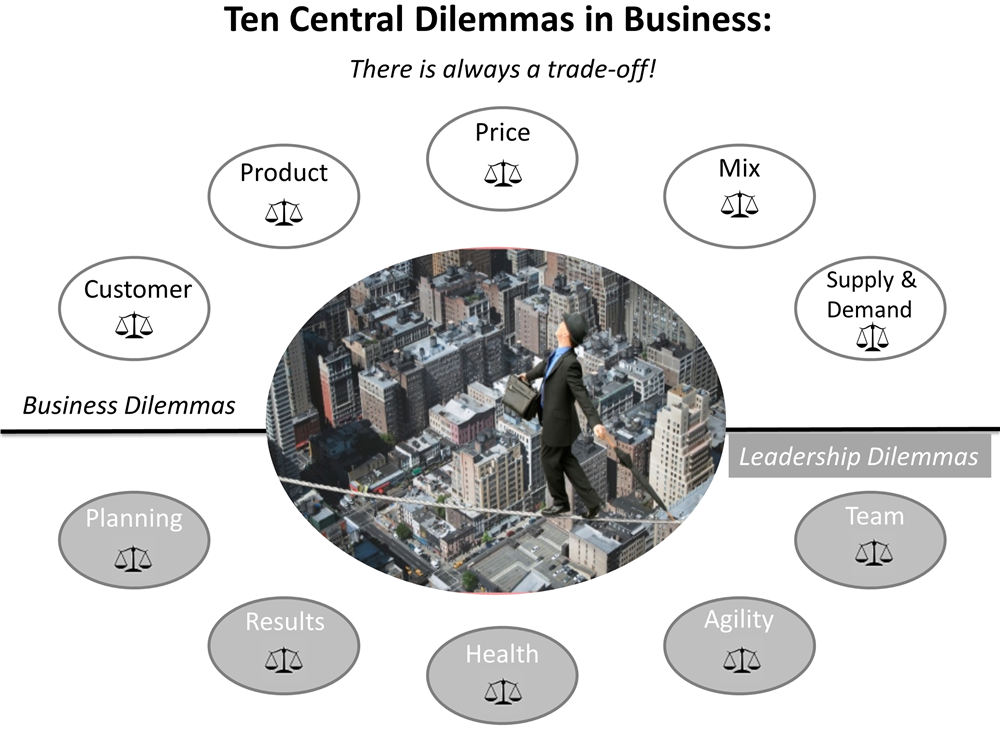Ten dilemmas you must master to become a top business leader
By Ken Thompson, Jul 28, 2017 Last updated Aug 19, 2025

Over the last 10 years, I have had the privilege of working closely with top performers in major enterprises to design business simulations and business games to match their organisational learning needs.
My discussions mostly concentrated on the key things which top performers did differently than others in their organisations to achieve their results. I call this approach dilemma-based design. DBD is a powerful technique to quickly discover the 3–4 most important aspects of any job or function.
A dilemma is a values conflict requiring a choice. It usually requires some kind of trade-off between two (or more) things you would like to protect or achieve. The difference between a dilemma and a decision is that there is always some pain or loss in a dilemma at the point of decision-making.
As these conversations developed, I became increasingly aware that despite the diversity of these businesses and the individuals who excelled in them, there seemed to be a common theme.
I made two discoveries about business dilemmas:
- Firstly, top performers welcome dilemmas and use them as platforms to excel
Let me be more specific – when faced with a dilemma, a top performer usually rejects the obvious responses for something a bit more thoughtful, entrepreneurial, and creative.
- Secondly, the same dilemmas keep reoccurring in every enterprise
Below I have summarised the 10 dilemmas which come up constantly, irrespective of the type of enterprise.
The first five dilemmas are business dilemmas which mostly concern the operation of the whole business unit, whereas the last five dilemmas are leadership dilemmas which mostly concern the operation of the executive team leading the business unit.
- The customer dilemma – How we decide which customers (or prospective customers) are most important at which times and how we might win their loyalty
- The product dilemma – How we optimise the contributions of our whole portfolio of products across their full lifetimes and decide how/when old products get retired and new products introduced
- The price dilemma – How we use pricing to optimise the ‘trinity’ of profit, demand and market share in different market conditions, and price to support products appropriate to their potential and maturities
- The mix dilemma – How we optimise the different options available to us in terms of products, markets and other factors (such as supply, geography and currency) to produce the best results at the lowest business risk
- The supply & demand dilemma – How we balance having too much supply of our product (or its components) versus too little to satisfy customer demand, and how we do so profitably
- The planning dilemma – How we balance developing comprehensive plans with mobilising plans through conversations, and avoid the pitfall of planning becoming ends in themselves
- The results dilemma – How we design and monitor a balanced set of measures which keep our eyes on the prize while providing effective tracking and early warning systems
- The health dilemma – How we deliver results today while protecting and enhancing our ability to deliver future results
- The agility dilemma – Our ability to respond to and learn from unexpected change, and how we design systems to warn of, build resilience to and respond to future shocks
- The team dilemma – How we balance being an effective, autonomous leader with being a supportive and loyal member of a senior team
You are going to encounter all these dilemmas sooner or later – so why not study and practise them now to accelerate your business acumen and commercial acumen skills?
A great way to experience the dilemmas is through a powerful team-based business simulation game, such as Acumen , which allows teams of leaders to immerse themselves in common dilemmas and become better equipped to handle them in real life.
I explore the ten dilemmas and the creative dilemma resolution process used by top performers in much more detail in my book: A Systematic Guide to Business Acumen and Leadership using Dilemmas .
